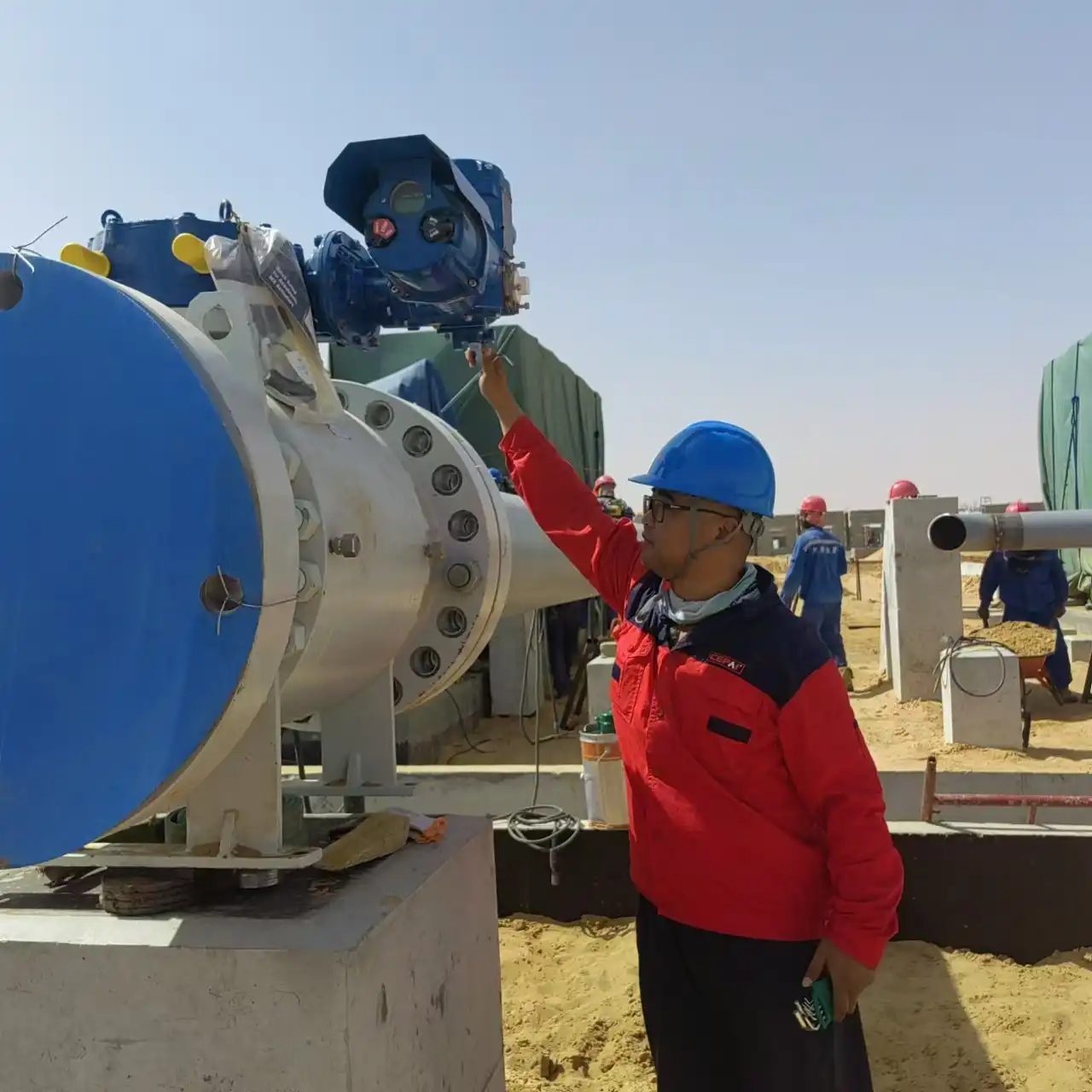Design and Operation: Butterfly Valve vs Ball Valve
Butterfly Valve Design and Functionality
Butterfly valves are characterized by their unique disc-shaped closure mechanism. The valve consists of a circular body with a central disc mounted on a rotating shaft. When the valve is fully open, the disc is parallel to the flow, allowing maximum passage of fluid. As the disc rotates 90 degrees, it gradually restricts the flow until it completely blocks the pipe when perpendicular to the flow direction.
The butterfly valve form is simple, which has a number of benefits. It doesn't take up much room when installed, which makes it perfect for situations where small size is important. Butterfly valves are also easy to handle and require less support because they are made of light materials. When used in big diameter applications, these valves work especially well and can save you a lot of money compared to other valve types.
Butterfly valves can be made in a wafer, lug, or flanged shape, among others. Each design has its own advantages when it comes to fitting options and the amount of pressure it can handle. The disc material and seat shape you choose can have a big effect on how well the valve works in different media and situations.
Ball Valve Construction and Operation
Butterfly valves feature a spherical closure element, typically referred to as the ball, with a bore through its center. The ball rotates around its axis to control fluid flow. When the bore aligns with the pipeline, the valve is fully open, allowing unrestricted flow. Rotating the ball 90 degrees closes the valve by positioning the solid part of the sphere across the flow path.
Because they are built to last, ball valves can be used in high-pressure situations. When it comes to binding, they work great, even in tough conditions. There are different styles of ball valves, such as floating ball, trunnion-mounted, and top-entry styles. There are a number of differences between the types that make each one useful for different operational needs.
One of the best things about ball valves is that they can shut off tightly with little force. Because of this, they are very useful in situations where a leak-free seal is important. Also, many ball valves' full-bore design means that there isn't much pressure drop when they're fully open. This makes them perfect for situations where keeping flow efficient is very important.
Comparing Actuation and Control
Both butterfly and ball valves can be equipped with various actuation systems, including manual handles, gear operators, and automated actuators. The type of actuation chosen depends on things like the size of the valve, the working pressure, and whether the control needs to be done remotely or automatically.
Butterfly valves usually need less force to work, especially when they are bigger. Because of this trait, devices can be made smaller and cheaper. Even though ball valves might need more torque, they can be operated with only a quarter turn, which makes automation and control methods easier.
In terms of control capabilities, both valve types can be designed for throttling applications. However, butterfly valves often provide more precise flow control over a wider range of positions due to the linear relationship between disc position and flow rate. Ball valves, while capable of throttling, are more commonly used for on-off service where their quick-acting nature is advantageous.
Performance Characteristics: Flow Control and Pressure Ratings
Flow Characteristics of Butterfly Valves
Butterfly valves exhibit unique flow characteristics that make them suitable for specific applications. The relationship between valve opening and flow rate is generally non-linear, with the most significant changes in flow occurring in the first 30 to 60 degrees of disc rotation. In some control situations, this nonlinear behaviour can be helpful because it lets flow rates be fine-tuned at smaller holes.
The flow capacity of butterfly valves is typically expressed in terms of Cv (flow coefficient) values. These values vary depending on the valve size, disc design, and opening percentage. High-performance butterfly valves with specialized disc shapes can offer improved flow characteristics and reduced pressure drop compared to standard designs.
One interesting thing about butterfly valves is that they can handle flow going both ways. Because of this, they can be used in a variety of systems where the flow direction might change or where backflow needs to be stopped. However, it's important to note that the presence of the disc in the flow path can create some turbulence and pressure drop, particularly at full opening.
Pressure Handling Capabilities of Ball Valves
Ball valves are renowned for their excellent pressure-handling capabilities. The spherical closure element, when in the closed position, is supported on all sides by the valve body and seats, allowing for high-pressure resistance. Because of this, ball valves are great for uses with fluids or gases that are under a lot of pressure.
The pressure rating of ball valves can vary significantly based on their design and materials of construction. Floating ball valves, where the ball is free to move slightly within the body, are typically used for lower to medium pressure applications. Trunnion-mounted ball valves, which anchor the ball at the top and bottom, are capable of handling higher pressures and larger valve sizes.
In terms of flow characteristics, ball valves offer a more linear relationship between valve opening and flow rate compared to butterfly valves. This predictability can be helpful in some control situations where changes in the flow need to be planned for. Full-bore ball valves, in particular, provide minimal obstruction to flow when fully open, resulting in lower pressure drops across the valve.
Comparative Analysis of Performance in Various Applications
It's important to look at how well butterfly valves and ball valves work in a variety of situations when comparing them. In low-pressure systems, such as water distribution networks, butterfly valves often provide a cost-effective solution due to their lightweight design and lower material costs. They work great in places where room is limited and cycling is required often.
On the other hand, ball valves are often the best choice for situations with a lot of pressure and heat, like in the oil and gas business. Because they are well-built and seal well, they are perfect for dealing with aggressive media and making sure there is no leaking.
If you want to slow something down, both types of valves can work, but each has its own advantages. Butterfly valves can be used to precisely control flow because they offer better control over a wider range of openings. Ball valves, while capable of throttling, are more commonly used in on-off services where their quick-acting nature is beneficial.
Maintenance, Longevity, and Cost Considerations
Maintenance Requirements for Butterfly Valves
People like butterfly valves because they don't need much upkeep, which makes them popular in many fields. The simple design, with fewer moving parts compared to many other valve types, reduces the potential for mechanical failures. Regular maintenance typically involves inspecting the disc, seat, and shaft for wear or damage.
One aspect of butterfly valve maintenance that requires attention is the seat material. Over time, the seat may experience wear due to frequent cycling or exposure to abrasive media. You can maintain the valve's appropriate closing ability by replacing the seat on a regular basis. Valve longevity can be increased by performing essential maintenance tasks such as lubricating the shaft and checking its straightness.

In applications where the valve remains in one position for extended periods, exercising the valve periodically can prevent seizing and ensure smooth operation. In emergency shutdown systems where stable valve operation is very important, this is especially important.
Longevity and Durability of Ball Valves
Ball valves are known for being strong and lasting a long time, especially in tough conditions. They last a long time because they are well-made and the sealing sides aren't exposed to the flow stream very much. Ball valves can work for years with little upkeep in many situations.
Keeping the ball and seat elements in good shape is important for keeping the ball valve working well. It is important to check these parts often for signs of damage, rust, or wear. Choosing the right materials and coatings for a valve can make it last a lot longer in harsh work situations, like when it's exposed to abrasive or corrosive media.
One benefit of some types of ball valves, like top-entry designs, is that repair can be done without taking the whole valve out of the pipeline. Important systems can have less downtime and easier maintenance using this option.
Cost Analysis: Initial Investment vs. Lifetime Value
When comparing the costs associated with butterfly valves and ball valves, it's important to consider both the initial investment and the long-term expenses. Due to their less complicated design and reduced material needs, butterfly valves typically have cheaper upfront costs, especially in bigger sizes. For projects with limited budgets or applications that require valve replacement frequently, they are a great choice.
Ball valves, while often more expensive initially, can offer significant long-term value in certain applications. You may end up spending less on repairs and replacements due to their longevity and superior sealing qualities. In high-pressure or critical service applications, the superior performance of ball valves may justify the higher initial investment.
Factors like as installation costs, possible downtime for maintenance, and replacement part costs must be considered when analysing costs. One possible benefit of butterfly valves is that they are less heavy and easier to install, which could lead to a decrease in installation costs. Because of their sturdy build, ball valves may save money in the long run by reducing the frequency of repairs needed and the amount of money lost due to leaks.
Conclusion
In each given situation, the unique needs of the application will dictate whether a ball valve or a butterfly valve is more appropriate. For applications requiring a small profile, cheap cost, and exact control of flow, especially in bigger sizes, butterfly valves are the way to go. Ball valves are preferred for high-pressure applications, tight shutoff requirements, and situations where long-term reliability is paramount. When engineers and facility managers take pressure ratings, flow characteristics, maintenance demands, and long-term expenses into account, they may optimise the efficiency, dependability, and cost-effectiveness of their fluid management systems.
Contact Us
Ready to optimize your valve selection? CEPAI Group offers expert guidance and high-quality valve solutions tailored to your specific needs. Our range of butterfly valves and ball valves are designed for superior performance across various industrial applications. Contact us at cepai@cepai.com to discuss how we can enhance your fluid control systems with our innovative products and unparalleled expertise.


_1746598531170.webp)



